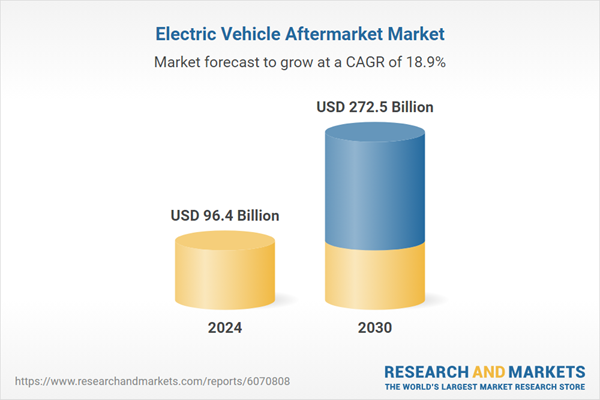The global market for Electric Vehicle Aftermarket was estimated at US$96.4 Billion in 2024 and is projected to reach US$272.5 Billion by 2030, growing at a CAGR of 18.9% from 2024 to 2030. This comprehensive report provides an in-depth analysis of market trends, drivers, and forecasts, helping you make informed business decisions. The report includes the most recent global tariff developments and how they impact the Electric Vehicle Aftermarket market.
Segments: Replacement Parts (Tire Replacement Parts, Battery Replacement Parts, Brake Parts Replacement, Filters Replacement Parts, Body Parts Replacement, Lighting & Electronic Components Replacement Parts, Wheels Replacement Parts, Other Replacement Parts); Propulsion (Battery Electric Vehicles Propulsion, Hybrid Electric Vehicles Propulsion, Fuel Cell Electric Vehicles Propulsion, Plug-in Hybrid Electric Vehicles Propulsion); Vehicle (Passenger Cars, Commercial Vehicles); Distribution Channel (Retailers, Wholesalers & Distributors)
Geographic Regions/Countries: World; United States; Canada; Japan; China; Europe (France; Germany; Italy; United Kingdom; Spain; Russia; and Rest of Europe); Asia-Pacific (Australia; India; South Korea; and Rest of Asia-Pacific); Latin America (Argentina; Brazil; Mexico; and Rest of Latin America); Middle East (Iran; Israel; Saudi Arabia; United Arab Emirates; and Rest of Middle East); and Africa.
The analysts continuously track trade developments worldwide, drawing insights from leading global economists and over 200 industry and policy institutions, including think tanks, trade organizations, and national economic advisory bodies. This intelligence is integrated into forecasting models to provide timely, data-driven analysis of emerging risks and opportunities.
Global Electric Vehicle Aftermarket - Key Trends & Drivers Summarized
How Is the EV Aftermarket Evolving in a Rapidly Electrifying World?
As electric vehicles (EVs) become a dominant force in the global automotive landscape, the electric vehicle aftermarket is undergoing a major transformation to align with the unique demands of this new mobility ecosystem. Unlike traditional internal combustion engine (ICE) vehicles, EVs have fewer mechanical components but require specialized parts, diagnostics, and services - reshaping the very foundation of the aftermarket industry. Components like electric motors, battery systems, inverters, and power electronics are now focal points, replacing items like oil filters, exhaust systems, and clutches that defined the conventional aftermarket. New business models are emerging around battery diagnostics, thermal management system servicing, software updates, and charging equipment maintenance. As EV adoption rises across personal, commercial, and fleet segments, demand is expanding for aftermarket services that cater specifically to these vehicles’ longevity and performance optimization. Furthermore, the rise in EV ownership is driving new expectations around digital-first service experiences, with mobile servicing, predictive maintenance, and connected diagnostics becoming standard offerings. This evolution is compelling traditional garages, dealerships, and independent service providers to invest in EV-specific tools, skills, and infrastructure to stay competitive in an increasingly electric future.Are Regulations and OEM Strategies Reshaping Aftermarket Access?
The structure of the EV aftermarket is being heavily influenced by evolving regulations and original equipment manufacturer (OEM) strategies. Globally, right-to-repair legislation is gaining traction, forcing automakers to provide independent repair shops with access to diagnostic data, proprietary software, and specialized training. The European Union and several U.S. states have enacted or are considering laws that mandate greater data transparency and component availability for non-OEM repair networks. Simultaneously, many OEMs are aiming to retain tighter control over the EV lifecycle, offering proprietary battery servicing, remote diagnostics, and over-the-air updates that limit third-party access. Some automakers are even bundling maintenance plans and battery warranties with vehicle purchases, extending customer loyalty while restricting aftermarket competition. Additionally, as the resale market for EVs grows, certified pre-owned (CPO) programs are being adapted to include EV-specific checks such as battery health scoring, powertrain recalibration, and software resets. These dynamics are altering the balance of power between independent aftermarket players and OEM networks, with collaboration, standardization, and digital integration becoming central to the future of service accessibility and competition.What Technologies Are Fueling the Growth of the EV Aftermarket?
Technological innovation is a driving force behind the modernization of the electric vehicle aftermarket, creating new revenue streams and redefining service standards. Battery analytics, thermal monitoring, and cloud-based diagnostics are now essential tools in understanding and managing EV health over time. The proliferation of telematics platforms enables real-time data collection on battery degradation, usage patterns, and component wear - empowering predictive maintenance and lifecycle management services. Emerging technologies like AI-powered diagnostics and augmented reality (AR) repair guidance are also entering the space, helping technicians navigate the complexities of high-voltage systems safely and accurately. Aftermarket players are also investing in software-driven services, including firmware upgrades, personalized range optimization algorithms, and in-app maintenance tracking. The growing demand for charging solutions is creating a secondary aftermarket around EV chargers, connectors, and home energy management systems. Meanwhile, 3D printing is opening up new avenues for producing low-volume replacement parts and components for aging EV models. Companies that offer modular battery packs, retrofitting solutions, and thermal management components are capturing niche demand within a rapidly diversifying aftermarket ecosystem.What Key Factors Are Driving the Expansion of the EV Aftermarket?
The growth in the electric vehicle aftermarket is driven by several factors related to vehicle lifecycle patterns, technology complexity, ownership trends, and service diversification. Firstly, the rising population of aging EVs - particularly early adopters from the last decade - is creating increasing demand for battery reconditioning, software updates, and non-drivetrain component replacements. Secondly, the inherently longer lifespan of EV platforms is shifting the aftermarket focus toward diagnostics, battery health monitoring, and digital service offerings rather than frequent mechanical replacements. Third, as EV adoption accelerates across fleets, ride-hailing, and commercial use cases, fleet managers are seeking scalable aftermarket support for battery analytics, part sourcing, and uptime optimization. Fourth, the direct-to-consumer service model - boosted by apps, mobile repair units, and subscription maintenance plans - is disrupting traditional dealership servicing norms. Fifth, the global shift toward circular economy practices is driving interest in remanufacturing, refurbishing, and recycling of EV parts, particularly battery modules, electronic controllers, and drive units. Additionally, increasing consumer comfort with digital ecosystems is fueling demand for remote diagnostics, smart service scheduling, and integrated aftermarket platforms. Collectively, these factors are steering the electric vehicle aftermarket toward a high-tech, data-centric, and service-first paradigm poised for significant and sustained growth.Report Scope
The report analyzes the Electric Vehicle Aftermarket market, presented in terms of market value (US$ Thousand). The analysis covers the key segments and geographic regions outlined below.Segments: Replacement Parts (Tire Replacement Parts, Battery Replacement Parts, Brake Parts Replacement, Filters Replacement Parts, Body Parts Replacement, Lighting & Electronic Components Replacement Parts, Wheels Replacement Parts, Other Replacement Parts); Propulsion (Battery Electric Vehicles Propulsion, Hybrid Electric Vehicles Propulsion, Fuel Cell Electric Vehicles Propulsion, Plug-in Hybrid Electric Vehicles Propulsion); Vehicle (Passenger Cars, Commercial Vehicles); Distribution Channel (Retailers, Wholesalers & Distributors)
Geographic Regions/Countries: World; United States; Canada; Japan; China; Europe (France; Germany; Italy; United Kingdom; Spain; Russia; and Rest of Europe); Asia-Pacific (Australia; India; South Korea; and Rest of Asia-Pacific); Latin America (Argentina; Brazil; Mexico; and Rest of Latin America); Middle East (Iran; Israel; Saudi Arabia; United Arab Emirates; and Rest of Middle East); and Africa.
Key Insights:
- Market Growth: Understand the significant growth trajectory of the Tire Replacement Parts segment, which is expected to reach US$64.0 Billion by 2030 with a CAGR of a 15.9%. The Battery Replacement Parts segment is also set to grow at 21.5% CAGR over the analysis period.
- Regional Analysis: Gain insights into the U.S. market, estimated at $26.3 Billion in 2024, and China, forecasted to grow at an impressive 25.1% CAGR to reach $62.1 Billion by 2030. Discover growth trends in other key regions, including Japan, Canada, Germany, and the Asia-Pacific.
Why You Should Buy This Report:
- Detailed Market Analysis: Access a thorough analysis of the Global Electric Vehicle Aftermarket Market, covering all major geographic regions and market segments.
- Competitive Insights: Get an overview of the competitive landscape, including the market presence of major players across different geographies.
- Future Trends and Drivers: Understand the key trends and drivers shaping the future of the Global Electric Vehicle Aftermarket Market.
- Actionable Insights: Benefit from actionable insights that can help you identify new revenue opportunities and make strategic business decisions.
Key Questions Answered:
- How is the Global Electric Vehicle Aftermarket Market expected to evolve by 2030?
- What are the main drivers and restraints affecting the market?
- Which market segments will grow the most over the forecast period?
- How will market shares for different regions and segments change by 2030?
- Who are the leading players in the market, and what are their prospects?
Report Features:
- Comprehensive Market Data: Independent analysis of annual sales and market forecasts in US$ Million from 2024 to 2030.
- In-Depth Regional Analysis: Detailed insights into key markets, including the U.S., China, Japan, Canada, Europe, Asia-Pacific, Latin America, Middle East, and Africa.
- Company Profiles: Coverage of players such as Aptiv PLC, BorgWarner Inc., BYD Company Limited, CATL (Contemporary Amperex Technology Co. Limited), Continental AG and more.
- Complimentary Updates: Receive free report updates for one year to keep you informed of the latest market developments.
Select Competitors (Total 44 Featured):
- Aptiv PLC
- BorgWarner Inc.
- BYD Company Limited
- CATL (Contemporary Amperex Technology Co. Limited)
- Continental AG
- Denso Corporation
- Dräxlmaier Group
- Everrati Automotive Limited
- Evice Cars
- Forvia (formerly Faurecia)
- Greaves Cotton Limited
- Hitachi Astemo Ltd.
- Magna International Inc.
- Panasonic Corporation
- Robert Bosch GmbH
- Siemens AG
- Sona BLW Precision Forgings Ltd. (Sona Comstar)
- TE Connectivity
- Valeo SA
- ZF Friedrichshafen AG
Tariff Impact Analysis: Key Insights for 2025
Global tariff negotiations across 180+ countries are reshaping supply chains, costs, and competitiveness. This report reflects the latest developments as of April 2025 and incorporates forward-looking insights into the market outlook.The analysts continuously track trade developments worldwide, drawing insights from leading global economists and over 200 industry and policy institutions, including think tanks, trade organizations, and national economic advisory bodies. This intelligence is integrated into forecasting models to provide timely, data-driven analysis of emerging risks and opportunities.
What’s Included in This Edition:
- Tariff-adjusted market forecasts by region and segment
- Analysis of cost and supply chain implications by sourcing and trade exposure
- Strategic insights into geographic shifts
Buyers receive a free July 2025 update with:
- Finalized tariff impacts and new trade agreement effects
- Updated projections reflecting global sourcing and cost shifts
- Expanded country-specific coverage across the industry
Companies Mentioned (Partial List)
A selection of companies mentioned in this report includes, but is not limited to:
- Aptiv PLC
- BorgWarner Inc.
- BYD Company Limited
- CATL (Contemporary Amperex Technology Co. Limited)
- Continental AG
- Denso Corporation
- Dräxlmaier Group
- Everrati Automotive Limited
- Evice Cars
- Forvia (formerly Faurecia)
- Greaves Cotton Limited
- Hitachi Astemo Ltd.
- Magna International Inc.
- Panasonic Corporation
- Robert Bosch GmbH
- Siemens AG
- Sona BLW Precision Forgings Ltd. (Sona Comstar)
- TE Connectivity
- Valeo SA
- ZF Friedrichshafen AG
Table Information
| Report Attribute | Details |
|---|---|
| No. of Pages | 485 |
| Published | April 2025 |
| Forecast Period | 2024 - 2030 |
| Estimated Market Value ( USD | $ 96.4 Billion |
| Forecasted Market Value ( USD | $ 272.5 Billion |
| Compound Annual Growth Rate | 18.9% |
| Regions Covered | Global |









